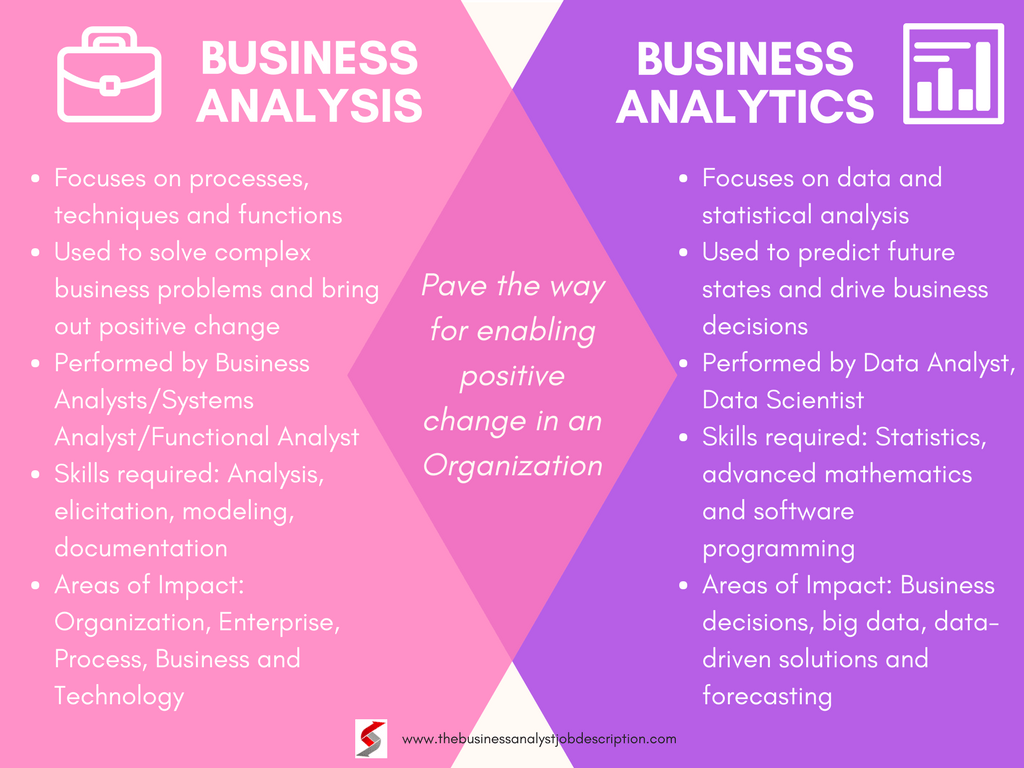With the growth in awareness and knowledge about the analysis and analytics domain, there is a visible increase in confusion regarding the real difference (and similarities) between Business Analysis and Business Analytics. I usually see a lot of questions/queries where people wanted to learn about analysis but were instead asking about analytics.
In this article, we will first learn about the formal definition and application of Business Analysis and Business Analytics, then go about understanding the differences between the two followed by the similarities and lastly see the skills required to excel in each one of these fields.
Business Analysis
BABoK says, “Business Analysis is the practice of enabling change in an organizational context, by defining needs and recommending solutions that deliver value to stakeholders.”
Now, that’s quite formal and complex definition. I would rather simplify it by re-phrasing Business Analysis as “Helping companies resolve their functional/technical obstacles by first understanding their problems, defining them and then solving them”. Most of the times, the only way to solve a problem is by changing the existing process/method/technique which is not working as expected and since business analysis does that, it’s called as a “practice of enabling change”. Additionally, if a company’s/organization’s problem is resolved, it will obviously benefit (in terms of revenue, profits, etc…) the people associated to that company/organization – thus business analysis “deliver value to stakeholders”.
Let’s see some of the activities that are performed while carrying out Business Analysis:
- Requirement Elicitation
- Requirement and Process Analysis
- Documentation of requirements
- As-is and To-be analysis
- Cost-Benefit Analysis
- Requirement Verification and Validation
- Change Management
Business analysis is carried out by Business Analysts, Systems Analyst, Functional Analyst and Business Requirements Analyst.
Business Analytics
According to Gartner, Business analytics is comprised of solutions used to build analysis models and simulations to create scenarios, understand realities and predict future states.
Quite heavy? Let’s distill the above explanation through an example. Suppose you are the product head of a mobile device manufacturing company and has been asked to do research about launching a new mobile phone. What all you will do? Let’s list down:
- Gathering details about usage of mobiles in the past 5 years
- Gather statistics about sales of mobiles (company wise, location wise, price wise) in the past 5 years
- Find out which mobiles were a success/failure by comparing the sales
- Assess what caused some mobiles to be successful and others to fail by comparing parameters like features, price, etc…
- Find out if there are any trends and insights in the details and numbers captured by you
- Predict the features required in your mobile phone, its price and number of sales for your mobile to be successful
Aren’t all the above steps quite logical? Yes, they are and that all what is done in business analytics. In the above steps, we performed data mining, statistical analysis and predictive analytics on historical business data/performance and they were done to gain insights and help in business planning and decision making. At a more complex level, business analytics can include algorithms, models and specialized tools to compare data gathered from different sources.
Business analytics is carried out by Data Analyst, Data Scientist
Difference between Business Analysis and Business Analytics
Let’s learn about the key differences between the two disciplines:
Business Analysis
- Focuses on processes, techniques and functions
- Used to solve complex business problems and bring out positive change
- Performed by Business Analysts, Systems Analyst, Functional Analyst
- Functional, business and domain knowledge is required to carry out business analysis
- Areas of Impact : Organization, Enterprise, Process, Business and Technology
Business Analytics
- Focuses on data and statistical analysis
- Used to predict future states and drive business decisions
- Performed by Data Analyst, Data Scientist
- Statistical, mathematical and programming knowledge is required for performing business analytics
Although both these disciplines look entirely different, they do share some commonalities and its explained with an example below.
Similarities between Business Analysis and Business Analytics
Despite the stark differences between Business Analysis and Business Analytics, eventually, analysis and analytics are used in cohesion and in turn aid each other in finding solutions to business problems.
Again, this can be best understood by an example – Most of us have used the electronic commerce website, Amazon. Here, when you inquire about a particular item, you are presented with a little suggestion box like this:
This “Frequently Bought Together” is an innovative and unconventional soft selling idea by Amazon where they entice the end user by politely suggesting that people who bought the item also bought these things as well – A great way to gain end user’s attention & curiosity and increase the chances of selling.
Now, let’s think about the feature in terms of Business Analysis: Amazon, possibly, would have questioned his research team on how can they increase the sales of their products without being too pushy. With this problem/requirement, the team of analysts would have devised an analysis plan and approach, gathered user data, considered various options, performed feasibility/cost-benefit/SWOT analysis, modeled the options through prototyping and after all the due verifications and validation, finally implemented the “Frequently Bought Together” functionality.
Now, that sounds pretty much all about the development of this feature. But wait, let’s see what part Business Analytics had to play here: To verify whether this feature is a useful option, a huge amount of historical customer buying data would have been statistically analyzed. This data would have been fed into algorithms and models to gain more insights about the buying patterns of users. This data would have then been classified based on products categories, demographics, geographical locations, etc… and compared with other possible suggestions. Finally, predictive analytics would have been used to forecast the chances of the success of this suggestion.
Can You see how business analytics played a pivotal role in analyzing and interpreting past performance which in turn helped in the overall business analysis of the feature? Both the disciplines, although very unique in their own right, were used hand in hand to pave the way for enabling positive change that delivered value to the organization (Amazon) and its stakeholders (Amazon’s customers).
Skills to excel in Business Analysis
Business analysis is a multi-faceted discipline and one has to be a jack of many skills to be an ace business analyst who is able to effectively draw out all the latent requirement, comprehensively document them in form of use cases/user stories, model them through UML/BPMN and handle change management of the requirements.
These skills are categorized as:
- Fundamental skills : Problem Solving, Communication, Management skills and Research skills
- Technical skills : Knowledge of IT skills, Software development understanding and Domain knowledge
- Business Analysis skills: Elicitation skills, documentation and comprehension skills and creativity.
You can get an in-depth view on each of the skills above and learn how to develop them by going through the article “Key Skills every Business Analyst must know”.
Skills to excel in Business Analytics
- Background in statistics – A previous educational background in statistics is although not mandatory but highly preferred to excel in the field of analytics as you already have a knack for numbers and details
- Programming skills and a mathematical perspective
- Data visualization capabilities – drawing out patterns, trends and correlation from the available data
- Reporting and Presentation skills – displaying your findings to a wider audience in a simpler format
Conclusion
As seen in the above examples, business analytics is predominantly used for segregating, clustering and categorizing similar data and then find relationships and meaning in them. Also, since its statistics and data heavy, its scope is limited to domains and industries where a previous historical data is available.
However, business analysis is universal in its approach and application and since it works on a set of pre-defined processes, it’s widely suited for a tackling lot of different problems belonging to diverse industries.
Next, check out How to prepare for Business Analyst Interview and Create Resumes that hiring managers love!!


